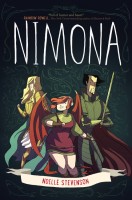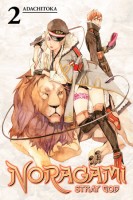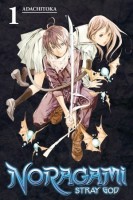My News and Reviews
Well, it was a little later than I initially intended, but I finally finished writing and posted my random musings on TCAF 2015 last week! It’s a long post which includes some of my general thoughts as well as write-ups of the panels that attended while at the festival. Even considering its length, people still seem to like it or at least find parts of it interesting, which makes me happy. Tangentially related to TCAF, I also posted and in-depth review of Wayward, Volume 1: String Theory, the first collection in an ongoing comic series created by Jim Zub and Steve Cummings. (Zub was one of the exhibitors at TCAF, though I picked up Wayward long before that.) The comic is heavily influenced by stories about yokai, but it definitely has its own modern twist on Japan’s myths and legends. String Theory is a great start to the series and I’m looking forward to reading the next volume.
Last week seemed to be oddly quiet on the news and licensing front. I’m sure there must have been some interesting things posted, but at least I didn’t come across very many. However, speaking of yokai, The New York Times recently published the article “Reviving Japan’s Dreaded and Beloved Ghosts” (or, “Pokémon’s Spooky Ancestors” if you try to look it up in the print edition) about some of the recent and forthcoming books being released in North America about the creatures. Vaguely related, Seven Seas announced that it has licensed Yoshihiko Inui’s Tomodachi x Monster, a dark parody manga series about kids and their pet monsters. Otherwise, if I’ve missed some particularly good reading, please do let me know!
Quick Takes
 Nimona by Noelle Stevenson. Originally an award-winning webcomic, Nimona was recently released as Stevenson’s debut graphic novel. The comic has been slightly revised for the print edition and additional content, including a new epilogue, has been collected in the volume as well. Nimona is one of my favorite comic releases so far this year. In the beginning it’s silly and very funny. But, while it never loses its humor, the comic does become more serious and even heart-wrenching as it progresses after some of the characters’ personal struggles and backgrounds are fully revealed. Nimona is a young shapeshifter who has decided that she will become the sidekick of Lord Ballister Blackheart, a supervillain whose plans are always being foiled by his arch-nemesis Sir Ambrosius Goldenloin. (The two men share a history together and deeply care about each other.) Nimona does manage to convince Blackheart to allow her to join his team, but finds his strict code of ethics frustrating to deal with. Likewise, he often frowns upon her excessively wild nature and propensity towards violence. Despite their differences, over time the two of them grow very close to each other. Nimona is an incredibly delightful and charming comic. I look forward to reading more of Stevenson’s work in the future.
Nimona by Noelle Stevenson. Originally an award-winning webcomic, Nimona was recently released as Stevenson’s debut graphic novel. The comic has been slightly revised for the print edition and additional content, including a new epilogue, has been collected in the volume as well. Nimona is one of my favorite comic releases so far this year. In the beginning it’s silly and very funny. But, while it never loses its humor, the comic does become more serious and even heart-wrenching as it progresses after some of the characters’ personal struggles and backgrounds are fully revealed. Nimona is a young shapeshifter who has decided that she will become the sidekick of Lord Ballister Blackheart, a supervillain whose plans are always being foiled by his arch-nemesis Sir Ambrosius Goldenloin. (The two men share a history together and deeply care about each other.) Nimona does manage to convince Blackheart to allow her to join his team, but finds his strict code of ethics frustrating to deal with. Likewise, he often frowns upon her excessively wild nature and propensity towards violence. Despite their differences, over time the two of them grow very close to each other. Nimona is an incredibly delightful and charming comic. I look forward to reading more of Stevenson’s work in the future.
 Noragami: Stray God, Volume 4 by Adachitoka. Even though Noragami seems to have been doing fairly well for Kodansha Comics, I haven’t really heard many people talking about the series. Initially I thought that Noragami was primarily going to be a comedy but the last few volumes, though they have their moments of levity, have actually been pretty serious. The fourth volume largely focuses on the plight of Bishamonten, a warrior god (technically goddess in Noragami). Though outwardly very strong and aggressive, she is having difficulty controlling and supporting the numerous shinki under her care. This does strike me as a little strange since Tenjin also has a large number of shinki without there seeming to be any negative consequences, but perhaps Bishamonten’s group is significantly bigger. It is interesting to see the differences in the relationships between the shinki and their respective gods in Noragami. After some strife in the last couple of volumes, Yato and Yuki have managed to forge an impressive partnership. Probably most importantly, they are at a point in their relationship where they can be honest with each other, airing their grievances and sharing their pain. The same cannot be said of Bishamonten and her shinki, which may be the source of their problems. Even though it is out of concern, hiding their true feelings is actually more damaging in the long run.
Noragami: Stray God, Volume 4 by Adachitoka. Even though Noragami seems to have been doing fairly well for Kodansha Comics, I haven’t really heard many people talking about the series. Initially I thought that Noragami was primarily going to be a comedy but the last few volumes, though they have their moments of levity, have actually been pretty serious. The fourth volume largely focuses on the plight of Bishamonten, a warrior god (technically goddess in Noragami). Though outwardly very strong and aggressive, she is having difficulty controlling and supporting the numerous shinki under her care. This does strike me as a little strange since Tenjin also has a large number of shinki without there seeming to be any negative consequences, but perhaps Bishamonten’s group is significantly bigger. It is interesting to see the differences in the relationships between the shinki and their respective gods in Noragami. After some strife in the last couple of volumes, Yato and Yuki have managed to forge an impressive partnership. Probably most importantly, they are at a point in their relationship where they can be honest with each other, airing their grievances and sharing their pain. The same cannot be said of Bishamonten and her shinki, which may be the source of their problems. Even though it is out of concern, hiding their true feelings is actually more damaging in the long run.
 xxxHolic, Omnibus 5 (equivalent to Volumes 13-15) by CLAMP. I’ve come to the realization that I much prefer xxxHolic when it isn’t being tied down with its association toTsubasa: Reservoir Chronicles. Fortunately, even though its connection to the other series continues to solidify in this omnibus, for the most part this portion of xxxHolic remains its own story without too much interference. Oddly enough, it even becomes a food manga of sorts, which I really wasn’t anticipating. Perhaps it’s not so surprising, though. Throughout xxHOlic Watanuki has always been shown to be cooking, making bento and snacks for the people who are important to him. But in the fifth omnibus of xxxHolic the cooking becomes critical to the story itself rather than just being a part of his character. (CLAMP also has a way of making the most mundane thing extraordinarily melodramatic to such an extent that a character’s very life seems to hang by a thread from it.) Watanuki teaches Kohane to cook because he wants to, but then he is hired out to fulfill the wish of one of the shop’s clients by providing instruction to her, too. Though at first he halfheartedly puts up a fight, he takes this task very seriously, eventually uncovering the woman’s true fears and desires. (All through the power of food!) There is also a sense of ominous foreboding in this volume as the series prepares for its finale.
xxxHolic, Omnibus 5 (equivalent to Volumes 13-15) by CLAMP. I’ve come to the realization that I much prefer xxxHolic when it isn’t being tied down with its association toTsubasa: Reservoir Chronicles. Fortunately, even though its connection to the other series continues to solidify in this omnibus, for the most part this portion of xxxHolic remains its own story without too much interference. Oddly enough, it even becomes a food manga of sorts, which I really wasn’t anticipating. Perhaps it’s not so surprising, though. Throughout xxHOlic Watanuki has always been shown to be cooking, making bento and snacks for the people who are important to him. But in the fifth omnibus of xxxHolic the cooking becomes critical to the story itself rather than just being a part of his character. (CLAMP also has a way of making the most mundane thing extraordinarily melodramatic to such an extent that a character’s very life seems to hang by a thread from it.) Watanuki teaches Kohane to cook because he wants to, but then he is hired out to fulfill the wish of one of the shop’s clients by providing instruction to her, too. Though at first he halfheartedly puts up a fight, he takes this task very seriously, eventually uncovering the woman’s true fears and desires. (All through the power of food!) There is also a sense of ominous foreboding in this volume as the series prepares for its finale.
 You & Me, Etc. by Kyugo. After I finished reading You & Me, Etc., I was extremely surprised to note that the boys’ love manga had been rated mature by the publisher. Honestly, nothing more than a few kisses and perhaps a little bit of cuddling happen in the manga. (The fact that it’s between men shouldn’t make a difference.) I believe You & Me, Etc. is the only manga by Kyugo to have been released in English. You & Me, Etc. is not an especially memorable collection of short boys’ love manga—none of the selections really have any sort of “hook” per se—but the stories are executed very well and it’s a very enjoyable volume. The stories included are quieter with a strong focus on the characters’ relationships and interactions. Some of those relationships aren’t even particularly romantic in nature (which will likely disappoint readers expecting or hoping for something a little steamier from a manga with an “M” rating), but nonetheless they are still very important and most often deal with some sort of love or affection. The volume features three couples (broadly defined) who must navigate and develop their relationships in the face of difficult circumstances, whether it be a life-changing accident, a shared secret, or a death in the family. Based on the volume’s strengths, I would certainly be interested in reading more of Kyugo’s work.
You & Me, Etc. by Kyugo. After I finished reading You & Me, Etc., I was extremely surprised to note that the boys’ love manga had been rated mature by the publisher. Honestly, nothing more than a few kisses and perhaps a little bit of cuddling happen in the manga. (The fact that it’s between men shouldn’t make a difference.) I believe You & Me, Etc. is the only manga by Kyugo to have been released in English. You & Me, Etc. is not an especially memorable collection of short boys’ love manga—none of the selections really have any sort of “hook” per se—but the stories are executed very well and it’s a very enjoyable volume. The stories included are quieter with a strong focus on the characters’ relationships and interactions. Some of those relationships aren’t even particularly romantic in nature (which will likely disappoint readers expecting or hoping for something a little steamier from a manga with an “M” rating), but nonetheless they are still very important and most often deal with some sort of love or affection. The volume features three couples (broadly defined) who must navigate and develop their relationships in the face of difficult circumstances, whether it be a life-changing accident, a shared secret, or a death in the family. Based on the volume’s strengths, I would certainly be interested in reading more of Kyugo’s work.






